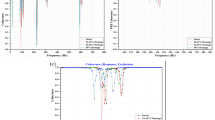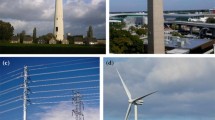Abstract
In the present work, the existence of multiple damage locations is identified successfully by using the modified mode shape curvature technique in a cantilever beam. The noisy frequency response of the beam is extracted for varying damage depths at two various positions by using Bruel and Kjaer instrument. As experimentally obtained displacement mode shape data cannot reflect clear damage location in the structure due to the presence of noise, in the present work, the data have been trained through artificial neural network to obtain improved results to localize the damage locations. Numerically and experimentally obtained displacement modes are utilized as input for ANN, and the trained data are used to produce mode shape curvature. The trained data sets are then utilized to produce the mode shapes curvatures for all the damage cases using central difference approximation. Damage severity and locations are then identified by analyzing the absolute mode shape curvature difference for various damage scenarios.














Similar content being viewed by others
Abbreviations
- FR:
-
Frequency response
- SHM:
-
Structural health monitoring
- ANN:
-
Artificial neural network
- ODS:
-
Operational deflection shape
- M :
-
Mass
- D :
-
Damping
- K :
-
Stiffness
- FFT:
-
Fast Fourier transfer
- X( \(\omega \) ) :
-
Output response
- F( \(\omega \) ) :
-
Input force
- S mm :
-
Power spectrum
- \({\gamma }^{2}\left(\omega \right)\) :
-
The coherence
- B&K:
-
Bruel and Kjaer
- MDOF:
-
Multiple degrees of freedom
- y” :
-
Curvature
- h :
-
Element size
- e x :
-
Experimental data set
- p x :
-
Predicted data set
- Z k :
-
Input/output data set
- Z k min, :
-
Data set (minimum)
- Z k max, :
-
Data set (maximum)
- MAPE:
-
Mean absolute percentage error
- MSE:
-
Mean square error
- R :
-
Regression coefficient
- AMSC:
-
Absolute mode shape curvature
- MMSC:
-
Modified mode shape curvature
- FEM:
-
Finite element method
References
Fan, W.; Qiao, P.: Vibration-based damage identification methods: a review and comparative study. Struct. Health Monit. 10(1), 83–111 (2011). https://doi.org/10.1177/1475921710365419
Moughty, J.J.; Casas, J.R.: A state of the art review of modal-based damage detection in bridges: development, challenges, and solutions. Appl. Sci. 7(5), 510 (2017). https://doi.org/10.3390/app7050510
Sohn, H.; Farrar, C.R.: Damage diagnosis using time series analysis of vibration signals. Smart Mater. Struct. 10(3), 446 (2001)
Adams, R.D.; Cawley, P.; Pye, C.J.; Stone, B.J.: A vibration technique for non-destructively assessing the integrity of structures. J. Mech. Eng. Sci. 20(2), 93–100 (1978). https://doi.org/10.1243/JMES_JOUR_1978_020_016_02
Cawley, P.; Adams, R.D.: The location of defects in structures from measurements of natural frequencies. J. Strain Anal. Eng. Design 14(2), 49–57 (1979). https://doi.org/10.1243/03093247V142049
Hassiotis, S.; Jeong, G.D.: Identification of stiffness reductions using natural frequencies. J. Eng. Mech. 121(10), 1106–1113 (1995). https://doi.org/10.1061/(ASCE)0733-9399(1995)121:10(1106)
Kim, J.-T.; Ryu, Y.-S.; Cho, H.-M.; Stubbs, N.: Damage identification in beam-type structures: frequency-based method vs mode-shape-based method. Eng. Struct. 25(1), 57–67 (2003). https://doi.org/10.1016/S0141-0296(02)00118-9
Pan, J.; Zhang, Z.; Wu, J.; Ramakrishnan, K.R.; Singh, H.K.: A novel method of vibration modes selection for improving accuracy of frequency-based damage detection. Compos. Part B: Eng. 159, 437–446 (2019). https://doi.org/10.1016/j.compositesb.2018.08.134
Shifrin, E.I.; Lebedev, I.M.: Identification of multiple cracks in a beam by natural frequencies. Euro. J. Mech.-A/Solids 84, 104076 (2020). https://doi.org/10.1016/j.jsv.2008.10.033
Sha, G.; Radzieński, M.; Cao, M.; Ostachowicz, W.: A novel method for single and multiple damage detection in beams using relative natural frequency changes. Mech. Syst. Signal Process. 132, 335–352 (2019)
Sampaio, R.P.C.; Maia, N.M.M.; Silva, J.M.M.: Damage detection using the frequency-response-function curvature method. J. Sound Vib. 226(5), 1029–1042 (1999). https://doi.org/10.1006/jsvi.1999.2340
Zang, C.; Imregun, M.: Structural damage detection using artificial neural networks and measured FRF data reduced via principal component projection. J. Sound Vib. 242(5), 813–827 (2001). https://doi.org/10.1006/jsvi.2000.3390
Maia, N.M.M.; Silva, J.M.M.; Almas, E.A.M.; Sampaio, R.P.C.: Damage detection in structures: from mode shape to frequency response function methods. Mech. Syst. Signal Process. 17(3), 489–498 (2003). https://doi.org/10.1006/mssp.2002.1506
Limongelli, M.P.: Frequency response function interpolation for damage detection under changing environment. Mech. Syst. Signal Process. 24(8), 2898–2913 (2010)
Bandara, R.P.; Chan, T.H.; Thambiratnam, D.P.: Structural damage detection method using frequency response functions. Struct. Health Monitor.6 13(4), 418–429 (2014). https://doi.org/10.1177/1475921714522847
Khanali, M.; Hayati-Soloot, A.; Høidalen, H.K.; Jayaram, S.: Study on locating transformer internal faults using sweep frequency response analysis. Electric Power Syst. Res. 145, 55–62 (2017)
Khatir, S.; Dekemele, K.; Loccufier, M.; Khatir, T.; Wahab, M.A.: Crack identification method in beam-like structures using changes in experimentally measured frequencies and Particle Swarm Optimization. Comptes Rendus Mécanique 346(2), 110–120 (2018). https://doi.org/10.1016/j.crme.2017.11.008
Liu, X.; Lieven, N.A.J.; Escamilla-Ambrosio, P.J.: Frequency response function shape-based methods for structural damage localisation. Mech. Syst. Signal Process. 23(4), 1243–1259 (2009). https://doi.org/10.1016/j.ymssp.2008.10.002
Pu, Q.; Hong, Yu.; Chen, L.; Yang, S.; Xikun, Xu.: Model updating–based damage detection of a concrete beam utilizing experimental damped frequency response functions. Adv. Struct. Eng. 22(4), 935–947 (2019). https://doi.org/10.1177/1369433218789556
Sampaio, R.P.C.; Maia, N.M.M.; Almeida, R.A.B.; Urgueira, A.P.V.: A simple damage detection indicator using operational deflection shapes. Mech. Syst. Signal Process. 72, 629–641 (2016)
Gandomi, A.H.; Sahab, M.G.; Rahaei, A.; Safari Gorji, M.: Development in mode shape-based structural fault identification technique. World Appl. Sci. J. 5(1), 29–38 (2008)
Elshafey, A.A.; Marzouk, H.; Haddara, M.R.: Experimental damage identification using modified mode shape difference. J. Marine Sci. Appl. 10(2), 150–155 (2011)
Gorgin R. Damage identification technique based on mode shape analysis of beam structures. In Structures, vol. 27, pp. 2300–2308. Elsevier, 2020. https://doi.org/10.1016/j.istruc.2020.08.034
Bianconi, F.; Salachoris, G.P.; Clementi, F.; Lenci, S.: A genetic algorithm procedure for the automatic updating of fem based on ambient vibration tests. Sensors 20(11), 3315 (2020). https://doi.org/10.3390/s20113315
Pandey, A.K.; Biswas, M.; Samman, M.M.: Damage detection from changes in curvature mode shapes. J. Sound Vib. 145(2), 321–332 (1991). https://doi.org/10.1016/0022-460X(91)90595-B
Lestari, W.; Qiao, P.; Hanagud, S.: Curvature mode shape-based damage assessment of carbon/epoxy composite beams. J. Intell. Mater. Syst. Struct. 18(3), 189–208 (2007). https://doi.org/10.1177/1045389X06064355
Qiao, P.; Kan, Lu.; Lestari, W.; Wang, J.: Curvature mode shape-based damage detection in composite laminated plates. Compos. Struct. 80(3), 409–428 (2007). https://doi.org/10.1016/j.compstruct.2006.05.026
Cao, M.; Radzieński, M.; Wei, Xu.; Ostachowicz, W.: Identification of multiple damage in beams based on robust curvature mode shapes. Mech. Syst. Signal Process. 46(2), 468–480 (2014)
He, J.; Zhou, Y.: A novel mode shape reconstruction method for damage diagnosis of cracked beam. Mech. Syst. Signal Process. 122, 433–447 (2019)
Rucevskis, S.; Wesolowski, M.: Identification of damage in a beam structure by using mode shape curvature squares. Shock Vib. 17(4–5), 601–610 (2010). https://doi.org/10.3233/SAV-2010-0551
Janeliukstis, R.; Ručevskis, S.; Kaewunruen, S.: Mode shape curvature squares method for crack detection in railway prestressed concrete sleepers. Eng. Fail. Anal. 105, 386–401 (2019). https://doi.org/10.1016/j.engfailanal.2019.07.020
Porcu, M.C.; Patteri, D.M.; Melis, S.; Aymerich, F.: Effectiveness of the FRF curvature technique for structural health monitoring. Constr. Build. Mater. 226, 173–187 (2019)
Ciambella, J.; Pau, A.; Vestroni, F.: Modal curvature-based damage localization in weakly damaged continuous beams. Mech. Syst. Signal Process. 121, 171–182 (2019). https://doi.org/10.1016/j.ymssp.2018.11.012
Anjneya K, Roy K, Response surface-based structural damage identification using dynamic responses." In Structures, vol. 29, pp. 1047–1058. Elsevier, 2021. https://doi.org/10.1016/j.istruc.2020.11.033
Nayyar, A.; Baneen, U.; Naqvi, S.A.Z.; Ahsan, M.: Detection and localization of multiple small damages in beam. Adv. Mech. Eng. 13(1), 1687814020987329 (2021). https://doi.org/10.1177/1687814020987329
Nick, H.; Aziminejad, A.: Vibration-based damage identification in steel girder bridges using artificial neural network under noisy conditions. J. Nondestr. Eval. 40(1), 1–22 (2021)
Lee, S.; Park, S.; Kim, T.; Lieu, Q.X.; Lee, J.: Damage quantification in truss structures by limited sensor-based surrogate model. Appl. Acoust. 172, 107547 (2021). https://doi.org/10.1016/j.apacoust.2020.107547
QX Lieu, VH Luong, J Lee. Structural damage identification using adaptive hybrid evolutionary firefly algorithm. In Applications of firefly algorithm and its variants, pp. 75–97. Springer, Singapore, 2020. https://doi.org/10.1007/978-981-15-0306-1_4
Yazdekhasti, S.; Piratla, K.R.; Atamturktur, S.; Khan, A.: Experimental evaluation of a vibration-based leak detection technique for water pipelines. Struct. Infrastruct. Eng. 14(1), 46–55 (2018). https://doi.org/10.1080/15732479.2017.1327544
Brigham, E.O.: The Fast Fourier Transform and Applications. Prentice Hall, Englewood Cliffs, NJ (1988)
Zenzen R, Samir Khatir, Belaidi I, Wahab MA. Structural health monitoring of beam-like and truss structures using frequency response and particle swarm optimization. In Numerical Modelling in Engineering, pp. 390–399. Springer, Singapore, 2018
Worden, K.; Farrar, C.R.; Haywood, J.; Todd, M.: A review of nonlinear dynamics applications to structural health monitoring. Struct. Control Health Monitor. Official J. Int. Assoc. Struct. Control Monitor. Euro. Assoc. Control Struct. 15(4), 540–567 (2008)
Bishop, C.M.: Neural networks for pattern recognition. Oxford University Press, Oxford (1995)
Ismail, H.M.; Ng, H.K.; Queck, C.W.; Gan, S.: Artificial neural networks modelling of engine-out responses for a light-duty diesel engine fuelled with biodiesel blends.". Appl. Energy 92, 769–777 (2012)
Yusaf, T.F.; Buttsworth, D.R.; Saleh, K.H.; Yousif, B.F.: CNG-diesel engine performance and exhaust emission analysis with the aid of artificial neural network. Appl. Energy 87(5), 1661–1669 (2010). https://doi.org/10.1016/j.apenergy.2009.10.009
Roy, S.; Banerjee, R.; Das, A.; Bose, P.K.: Development of an ANN based system identification tool to estimate the performance-emission characteristics of a CRDI assisted CNG dual fuel diesel engine. J. Nat. Gas Sci. Eng. 21, 147–158 (2014). https://doi.org/10.1016/j.jngse.2014.08.002
Basheer, I.A.; Hajmeer, M.: Artificial neural networks: fundamentals, computing, design, and application. J. Microbiol. Methods 43(1), 3–31 (2000). https://doi.org/10.1016/S0167-7012(00)00201-3
Bhowmik S., Panua R., Debroy D., Paul A. "Artificial neural network prediction of diesel engine performance and emission fueled with Diesel–Kerosene–Ethanol Blends: A fuzzy-based optimization." J. Energy Resour. Technol. 139 no. 4 (2017)
Hassoun, M.H.: Fundamentals of artificial neural networks. MIT press, Cambridge (1995)
Badri, L.: Development of neural networks for noise reduction. Int. Arab J. Inf. Technol. 7(3), 289–294 (2010)
Modal-based FE model updating via Genetic Algorithms: exploiting artificial intelligence to build realistic numerical models of historical structures. “Construction and Building Materials” 2021
Author information
Authors and Affiliations
Corresponding author
Ethics declarations
Conflict of interest
The authors declare that they have no conflict of interest.
Rights and permissions
About this article
Cite this article
Gupta, S.K., Das, S. Multiple Damage Identification in a Beam Using Artificial Neural Network-Based Modified Mode Shape Curvature. Arab J Sci Eng 47, 4849–4864 (2022). https://doi.org/10.1007/s13369-021-06267-2
Received:
Accepted:
Published:
Issue Date:
DOI: https://doi.org/10.1007/s13369-021-06267-2




